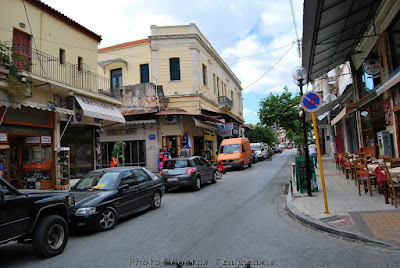After leaving the narrow streets of the Old Jewish neighborhood, you end up in the main street leading to the old port. There are some really interesting old buildings to see.
Αφίνοντας πίσω τα στενά σοκακια της εβραικής συνοικίας, μπαίνεις στην οδό Χάληδων και κατηφορίζοντας προς το λιμάνι, συναντάς μερικά ενδιαφέροντα παλιά κτίρια.
On your right you will see the town Cathedral, dedicated to Holy Mary. It is built at the place where an older church was, which the Turks had converted to soap factory. Later, a local turkish official who owned the factory, al;lowed the Christians to rebuild the church which was completed in 1860. It has some very nice wall paintings.
Στα δεξιά σας θα δείτε τον καθεδρικό ναό των Εισοδίων της Θεοτοκου. Είναι χτισμένος στην θέση ενός παλιότερου ναού των Εισοδίων, που στα χρόνια της Τουρκοκρατίας είχε μετατραπεί σε σαπωνοποιείο. Αργότερα, ο ιδιοκτήτης του ονομαστός Μουσταφά Πασάς, ο επωνομαζόμενος Γκιριτλής (Κρητικός), έδωσε την άδεια στους χριστιανούς να τον ξαναχτίσουν και μάλιστα λέγεται ότι συνεισέφερε στα έξοδα της ανέγερσης. Ολοκληρώθηκε το 1860 και κοσμείται με ενδιαφέρουσες αγιογραφίες.
Next to the cathedral you can see this old turkish building. It is a Hamam or turkish baths. I remember this place in the 60.s to be a bell making workshop. They were melting bronze and other kinds of metal, and were making small or larger bells in moulds. They were also making bronze candle stands for the churches.
Πάνω στον κεντρικό δρόμο, δίπλα στήν Μητρόπολη, είναι το παλιό τούρκικο Χαμάμ. Το θυμάμαι στην δεκαετία του 60, να λειτουργεί σαν καμπανοχυτήριο. Έλιωναν μπρούτζο και άλλα μέταλλα και σε καλούπια που έφτιαχναν επί τόπου, έχυναν τις καμπάνες μικρές ή μεγάλες. κατασκεύαζαν επίσης μπρούτζινα μανουάλια και άλλα σκεύη για τις εκκλησίες.
Across the street is the entrance to the yard of the Catholic Church.
Η είσοδος και η αυλή της Καθολικής Εκκλησίας στην απέναντι πλευρά του δρόμου.
Next to the Catholic Church is the entrance to the archeological Museum. It was an old Catholic Monastery of Fragiscan Monks. Its houses findings from Chania County, which they date back to prehistoric era (3rd and 2nd millennium BC) up to post Roman period.
Δίπλα στην είσοδο της Καθολικής Εκκλησίας είναι το Αρχαιολογικό Μουσείο των Χανίων, σ' έναν χώρο που παλιότερα ήταν Καθολικό Μοναστήρι Φραγκισκανών Μοναχών. Έχει εκθέματα από την περιοχή των Χανίων που χρονολογούνται στους προιστορικούς χρόνους (3η και 2η χιλιετία π.Χ.) μέχρι τους μετα-Ρωμαικούς χρόνους.
















12 comments:
Costas, fantastic photos and stories. There is NOTHING that old where I live. Not even close...
thanks again for taking us on a tour!
It looks like a beautiful place! And you have sun! I am envious.
Excellent photographs and a good history lesson.
No doubt very good as always.
Warm greetings.
Cada vez que entro nesse blog é uma viagem que faço... que belas fotos!
Parabéns pelo seu trabalho, ele é muito rico.
Beijos.
Βούρ για το...τυπογραφείο!
Ο ταξιδιωτικός οδηγός των Χανίων βλέπω είναι ολοκληρωμένος και εμπεριστατωμένος!
Great photos and stories that really bring the history and feel of the old city to life.
Darryl and Ruth : )
Imagine a bell factory turned int a Hamaam! Very nice photos and information!Have a good Sunday!
beautiful presentation..wonderful city!
Amazing set of pictures!I'm enchanted by that Cathedral and the angle that you took this fabulous picture!
Happy Sunday
Léia
Thank you for this fascinating tour of Chania Crete. I enjoyed all of your pictures.
Can you tell me who the statue is? I love that.
The ancient buildings, the ancient "feel", the history - the beauty here ... I have enjoyed this series so much. I will probably never be able to visit Chania myself, but I feel like I have been there through your words and photos!
Thank you so much for the tour.
Post a Comment